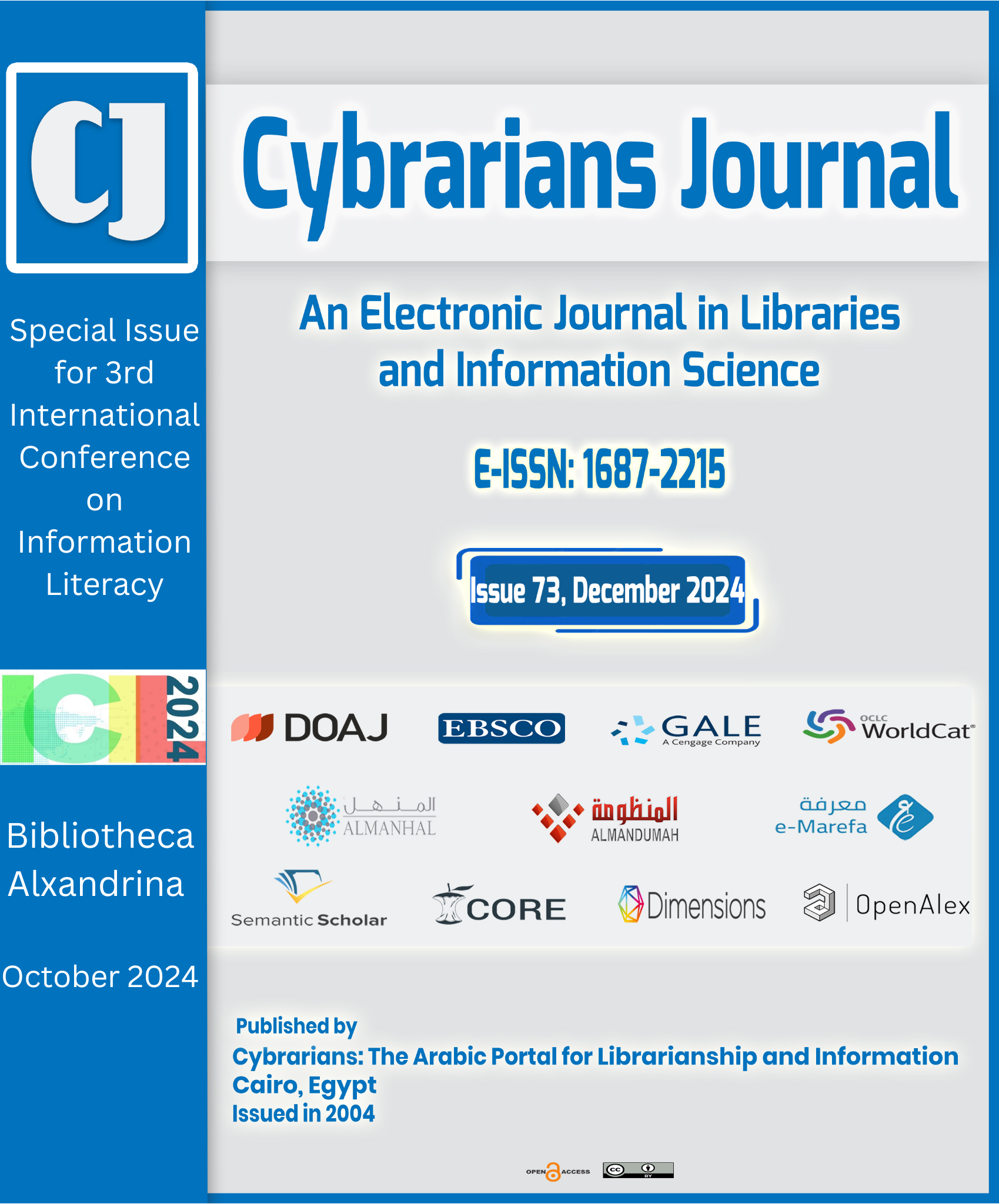Understanding the impact of AI Hallucinations on the university community
DOI:
https://doi.org/10.70000/cj.2024.73.622Keywords:
Artificial Intelligence, Natural language, AI Hallucinations, AI literacy, Information literacyAbstract
Since we live in the era of the information revolution, finding trusted and accurate information takes time and effort made students and researchers aim to find an easier way. Generative AI (Artificial Intelligence) tools offer an easy solution for accessing the required information easily and accessible; however, these tools rely on vast datasets to predict statistically probable outputs, not guaranteed ac- curacy. This can lead to misinformation, factual errors, biases, and fabricated content, which is termed "hallucinations." The research problem focuses on the challenges of detecting these AI hallucinations, the main issue for all users of AI technologies. The main objective of the study is to raise awareness about AI hallucinations and promote the ethical and effective use of AI tools among New Giza University students, faculty, and staff. This involves the approach to understanding the biases and errors associated with AI outputs. Methodologically, the study will employ a mixed-methods approach, combining quantitative analyses of AI tool accuracy with collecting qualitative data via survey of users across a range of fields to gather insights on the impact of AI hallucinations. The expected results of this research are to reveal the pitfalls that researchers might run into when relying on AI technology for their work. Additionally, the findings will contribute significantly to information literacy programs, by advocating for the including of AI tool assessments within the broader information literacy curriculum and equipping users with the skills to critically evaluate AI-generated content.
References
Ahmad, M. A., Yaramis, I., & Roy, T. D. (2023). Creating trustworthy LLMs: Dealing with hallucinations in healthcare AI [arXiv preprint]. https://arxiv.org/abs/2311.01463v1
Ahn, C., & Kim, J. H. (2023). AntiHalluciNet: A potential auditing tool of the behavior of deep learning denoising models in low-dose computed tomography. Diagnostics, 14(1), 96. https://doi.org/10.3390/diagnostics14010096
Athaluri, S. A., Manthena, S. V., Kesapragada, V. S. R. K. M., Yarlagadda, V., Dave, T., & Duddumpudi, R. T. S. (2023). Exploring the boundaries of reality: Investigating the phenomenon of artificial intelligence hallucination in scientific writing through ChatGPT references. Cureus. https://doi.org/10.7759/cureus.37432
Brownlee, J. (2023, July 17). A gentle introduction to prompt engineering. Machine Learning Mastery. https://machinelearningmastery.com/a-gentle-introduction-to-prompt-engineering/
ElFangary, L. M. (2024). Roadmap for generative models redefining learning in Egyptian higher education. International Journal of Advanced Computer Science and Applications, 15(2), 144. http://www.ijacsa.thesai.org
Gao, Y., Wang, J., Lin, Z., & Sang, J. (2024). AIGCs confuse AI too: Investigating and explaining synthetic image-induced hallucinations in large vision-language models. Beijing Jiaotong University & Peng Cheng Lab.
Gold, P. (n.d.). User awareness and education for generative AI [Online course]. Coursera Instructor Network. Coursera. https://www.coursera.org/learn/user-awareness-and-education-for-generative-ai
IBM Corporation. (2024). Glossary | IBM watsonx. https://dataplatform.cloud.ibm.com/docs/content/wsj/wscommon/glossary-wx.html?context=wx#x10298036. Retrieved July 22, 2024.
Iorliam, A., & Ingio, J. A. (2024). A comparative analysis of generative artificial intelligence tools for natural language processing. Journal of Combinatorial Theories and Applications. https://doi.org/10.62411/jcta.9447
Ji, Z., Lee, N., Frieske, R., Yu, T., Su, D., Xu, Y., Ishii, E., Bang, Y., Chen, D., Dai, W., Chan, H. S., Madotto, A., & Fung, P. (2022). Survey of hallucination in natural language generation. ACM Computing Surveys, 1(1), Article. https://doi.org/10.1145/0360-0300/2022/2-ART
Kim, H., & Lee, S. W. (2024). Investigating the effects of generative-AI responses on user experience after AI hallucination. In Proceedings of the MBP 2024 Tokyo International Conference on Management & Business Practices (pp. 92-101). Social Science and Humanities Research Association (SSHRA).
Leiser, F., Eckhardt, S., Leuthe, V., Knaeble, M., Maedche, A., Schwabe, G., & Sunyaev, A. (2024). HILL: A hallucination identifier for large language models. Institute of Applied Informatics and Formal Description Methods, Karlsruhe Institute of Technology.
Maleki, N., Padmanabhan, B., & Dutta, K. (2024). AI hallucinations: A misnomer worth clarifying. arXiv. https://arxiv.org/abs/2401.06796v1
McGrath, K. (2021). Accuracy and explainability in artificial intelligence: Unpacking the terms [Short paper]. In Proceedings of the Forty-Second International Conference on Information Systems. Brunel University London.
Mozelius, P., & Humble, N. (2024). On the use of generative AI for literature reviews: An exploration of tools and techniques. In Proceedings of the 23rd European Conference on Research Methodology for Business and Management Studies (ECRM 2024). Mid Sweden University, University of Gävle, & Uppsala University.
Najjar, R. (2023, July 12). Preliminary understanding of generative AI: What & how? Medium. https://medium.com/@rachad.najjar/preliminary-understanding-of-generative-ai-what-how-7add139620b4
Perkins, M., & Roe, J. (2024). Generative AI tools in academic research: Applications and implications for qualitative and quantitative research methodologies [Preprint]. British University Vietnam.
Rawte, V., Chakraborty, S., Pathak, A., Sarkar, A., Tonmoy, S. M. T., Chadha, A., Sheth, A., & Das, A. (2023). The troubling emergence of hallucination in large language models – An extensive definition, quantification, and prescriptive remediations. AI Institute, University of South Carolina; Christ University; Islamic University of Technology; Stanford University; Amazon AI.
Rawte, V., Priya, P., Tonmoy, S. M. T., Zaman, S. M. M., Sheth, A., & Das, A. (2023). Exploring the relationship between LLM hallucinations and prompt linguistic nuances: Readability, formality, and concreteness [arXiv preprint]. https://arxiv.org/abs/2309.11064v1
Salhab, R. (2024). AI literacy across curriculum design: Investigating college instructors’ perspectives. Online Learning, 28(2), 22-47. https://doi.org/10.24059/olj.v28i2.4426
Saudi Data and Artificial Intelligence Authority. (2023, November). Generative artificial intelligence (Generative artificial intelligence series No. 1). Saudi Data and Artificial Intelligence Authority. https://sdaia.gov.sa/ar/MediaCenter/KnowledgeCenter/Pages/SDAIAPublications.aspx
Saudi Data and Artificial Intelligence Authority. (2023, November). Large Language Models (Generative artificial intelligence series No. 2). Saudi Data and Artificial Intelligence Authority. https://sdaia.gov.sa/ar/MediaCenter/KnowledgeCenter/Pages/SDAIAPublications.aspx
Shi, W. L. (2023). Efficacy of educational misinformation games [arXiv preprint]. https://arxiv.org/abs/2305.09429v1
Song, Y., He, Y., Zhao, X., Gu, H., Jiang, D., Yang, H., Fan, L., & Yang, Q. (n.d.). A Communication Theory Perspective on Prompting Engineering Methods for Large Language Models. arXiv.org. https://arxiv.org/abs/2310.18358
Zaimah, N. R., Hartanto, E. B., & Zahro, F. (2024). Acceptability and effectiveness analysis of large language models-based artificial intelligence chatbots among Arabic learners. Mantiqu Tayr: Journal of Arabic Language, 4(1).
Downloads
Additional Files
Published
How to Cite
Issue
Section
License
Copyright (c) 2024 Hend Kamel

This work is licensed under a Creative Commons Attribution 4.0 International License.







